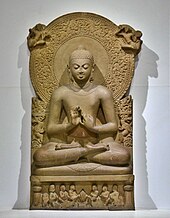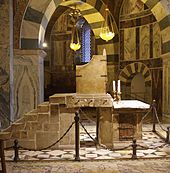throne

As a throne (including above the Latin thronus , 'sublime seat, throne' ; this from ancient Greek θρόνος thrónos , German , 'armchair, chair with stool for the feet, seat of the gods, royal throne' (in the latter sense mostly plural , but also singular )) the usually elaborately designed chair is called the insignia of a monarch , on which he takes a seat on special occasions. A distinction is often made between “throne” and “throne seat” (without back or armrests).
History and religion
Antiquity
In ancient times, thrones were the symbol of kings and gods from the beginning . The throne was used for the coronation ceremonies and enthronement . The throne was assigned a direct connection with royal power. For the Hittites , the thrones themselves were gods. The Greeks reserved by Homer an additional empty throne in the royal palace and temples for the gods. The most famous of these thrones was the throne of Apollo at Amyklai . The Romans also had two thrones, one for the emperor and one for the goddess Roma , whose enthroned statues became the religious center.
Bible
The Old Testament does not linguistically differentiate between chair and throne. The description of the throne of Solomon ( 1 Kings 10.18-20 EU ) was used again and again in the fine arts (throne chair of God, Mary, Jesus, the holy bishops, King Solomon), but also in the appendix of Thrones taken as a model, most recently probably in that of the throne for Kaiser Wilhelm II in the Palazzo Caffarelli by the Berlin architect Alfred Messel (1894–1898). In the Middle Ages , the throne of Solomon was associated with Mary .
In the New Testament Jesus promised the apostles a place on the "twelve thrones" where the twelve tribes of Israel would judge ( Mt 19.28 EU ).
The seer John sees in Revelation : “Then I saw a great white throne and the one who sat on it; before his sight the earth and heaven fled and there was no more room for them ”( Rev 20:11 EU ).
church
In the hierarchy of the Catholic Church , the seat of the bishop is a throne, the cathedra . The Pope's throne is the Kathedra Petri (see also Holy See ). Today the throne in the Catholic Church has only symbolic and ceremonial meaning. If early Romanesque churches have a westwork , a princely throne was located in it as a symbolic opposite of the altar (spiritual and secular power). In many medieval depictions of the Last Judgment , God's throne is replaced by a rainbow . The numerous Coronations of the Virgin Mary in European cathedral Gothic usually feature a raised and decorated seat.
Royal throne
For a long time, the establishment of the throne was an important element in the ascension of the king , for example in 936 when Otto I was elected to the throne of the Charles throne in Aachen . The duke's chair was of similar importance when the dukes were raised, but because of the lack of a coronation, the throne is even more constitutive here.

India
- Buddhism
Buddha is more often shown seated on an ornate throne; A distinction must be made between two sitting postures - lotus seat and “European seat”.
- Hinduism
The god couple Shiva and Parvati are also often shown on a throne seat (without a backrest) (see Uma-Maheshwara or Somaskanda ). Later portraits sometimes show Durga and other gods of the Hindu pantheon on a richly decorated throne.

Islam
Thrones are also mentioned in the Koran: "And it is He (God) who created heaven and earth in six days and his throne was on the water" (sura 11, verse 6). Richly decorated thrones or throne seats are known from Persian and Indian rulers of the Mughal period .
Maya
The classical and late Maya art also knew thrones or throne seats; the most important example is the throne of Piedras Negras , Guatemala.
List of known thrones

- Solomon's throne
- Apollo's throne , Amyklai
- King Edward's Throne , Westminster Abbey
- Aachen royal throne of Charlemagne , Aachen Cathedral , 8th century
- Kaiserstuhl Goslar
- Emperor Wilhelm II's throne , Posen Residenzschloss , 1910, by Franz Schwechten
- Throne of Emperor Wilhelm II, German Embassy Rome , 1894/98, by Alfred Messel
- Danish ivory and narwhale teeth throne in Copenhagen's Rosenborg Castle , around 1640, by Bendix Grodtschilling
- Cathedra Petri , Pope's throne
- Sedia gestatoria , portable papal throne
- Peacock Throne, original throne of the Mughal rulers of India, deported to Persia and then throne of the Shah of Persia
- Chrysanthemum throne, throne of the Japanese Tennos
- Dragon throne, throne of the Chinese emperor
- Phoenix throne, throne of the Korean kings
- Lion throne, throne of the Dalai Lama
- Jaguar throne, throne of the Mayan princes .
Anecdotal
The State Spelling Conference of 1901 declared Konrad Dudens' rules of spelling to be generally binding. These rules also included the fact that in the words beginning with “t”, which until then had always been written with “h” after the “t” (e.g. “That”), this “h” was omitted. The fact that the th spelling was retained in throne was often attributed to a personal influence of the last German emperor Wilhelm II . The "th" was retained anyway - and to this day - in all Greek loanwords where it represents a theta (as in theater or mathematics , where the second "t" corresponds to a tau ). The throne was at no time orthographically endangered.
literature
- H. Eickhoff: heavenly throne and rocking chair. The story of sitting. Hanser, Munich / Vienna 1993, ISBN 3-446-17376-5 .
- Hartwig Fischer : A Wilhelmine total work of art on the Capitol. Hermann Prell and the establishment of the throne room in the German Embassy in Rome 1894–1899. Mewe-Verlag, Basel 1998, ISBN 3-9806066-1-9 .
- H. Jung: Enthroned and seated gods: on the Greek idol and human ideal in the geometric and early Archaic times. Habelt, Bonn 1982, ISBN 3-7749-1918-6 .
- H. Kyrieleis :: Thrones and Klinen. Studies on the history of forms of ancient oriental and Greek seating and reclining furniture from the pre-Hellenistic period. de Gruyter, Berlin 1969, DNB 367466880 .
- M. Metzger: royal throne and divine throne. Throne forms and representations of thrones in Egypt and the Middle East in the third and second millennium BC and their significance for understanding statements about the throne in the Old Testament. (= Old Orient and Old Testament. 15/1 (text), 15/2 (catalog and plates)). Neukirchener Verlag, Neukirchen-Vluyn 1985, ISBN 3-7887-0724-0 .
Web links
Single receipts
- ^ Karl Ernst Georges : Comprehensive Latin-German concise dictionary . 8th, improved and increased edition. Hahnsche Buchhandlung, Hannover 1918 ( zeno.org [accessed on February 12, 2020] dictionary entry “thronus”).
- ^ Wilhelm Pape , Max Sengebusch (arrangement): Concise dictionary of the Greek language . 3rd edition, 6th impression. Vieweg & Sohn, Braunschweig 1914 ( zeno.org [accessed on February 12, 2020]).
- ^ Thron - Duden , Bibliographisches Institut ; 2016


